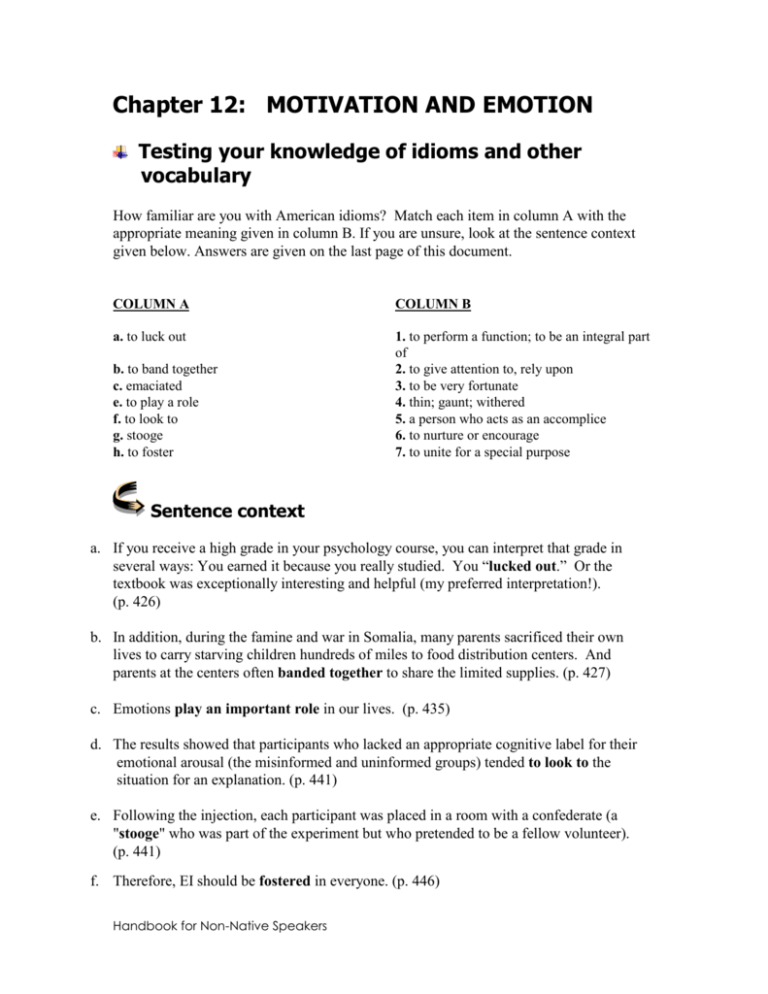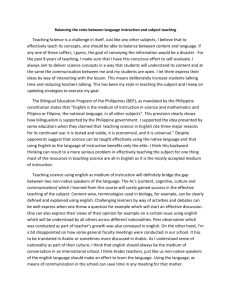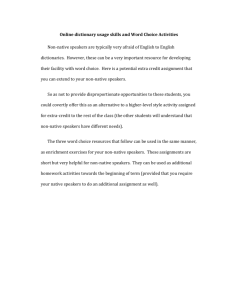Chapter 12: MOTIVATION AND EMOTION
advertisement

Chapter 12: MOTIVATION AND EMOTION Testing your knowledge of idioms and other vocabulary How familiar are you with American idioms? Match each item in column A with the appropriate meaning given in column B. If you are unsure, look at the sentence context given below. Answers are given on the last page of this document. COLUMN A COLUMN B a. to luck out 1. to perform a function; to be an integral part of 2. to give attention to, rely upon 3. to be very fortunate 4. thin; gaunt; withered 5. a person who acts as an accomplice 6. to nurture or encourage 7. to unite for a special purpose b. to band together c. emaciated e. to play a role f. to look to g. stooge h. to foster Sentence context a. If you receive a high grade in your psychology course, you can interpret that grade in several ways: You earned it because you really studied. You “lucked out.” Or the textbook was exceptionally interesting and helpful (my preferred interpretation!). (p. 426) b. In addition, during the famine and war in Somalia, many parents sacrificed their own lives to carry starving children hundreds of miles to food distribution centers. And parents at the centers often banded together to share the limited supplies. (p. 427) c. Emotions play an important role in our lives. (p. 435) d. The results showed that participants who lacked an appropriate cognitive label for their emotional arousal (the misinformed and uninformed groups) tended to look to the situation for an explanation. (p. 441) e. Following the injection, each participant was placed in a room with a confederate (a "stooge" who was part of the experiment but who pretended to be a fellow volunteer). (p. 441) f. Therefore, EI should be fostered in everyone. (p. 446) Handbook for Non-Native Speakers Reviewing your knowledge of English grammar In the previous chapter, we began to discuss the use of relative clauses for the addition of information and definitions. Relative clauses can also be used to identify a specific segment of individuals within a larger group. In other words, the relative clause is used to limit the discussion to only those group members that meet the criteria expressed by the relative clause. For example: Human patients who have had their stomachs removed in cancer operations report normal feelings of hunger. The group being discussed in this case, human patients, does not refer to all human patients, but rather is restricted to only those with their stomachs removed due to cancer operations: all human patients human patients with no stomachs due to illness This type of relative clause, called a restrictive relative clause, is similar in formation to the nonrestrictive relative clauses. They can be viewed as a sentence within a sentence, and usually require a relative pronoun to serve as the connection between the shared nouns. It is interesting to note that in restrictive relative clauses, the relative pronoun who is used with people, whereas that or which is used with things and ideas. Note the difference in punctuation as well: there are no commas used with restrictive relative clauses. Study the following examples: can you see how the relative clause restricts the group from the larger whole? I sometimes like to do things that are a little frightening. People who diet too much may have a self-defeating attitude about weight loss. Handbook for Non-Native Speakers For each category, we will discuss only the representative motive which has been the most widely researched. Further evidence of this lack of connection was provided in experiments in which rats had their stomachs removed. See how well you can construct restrictive relative clauses using the sentences below. Be sure to locate the common noun in the two sentences in order to combine them effectively and pay close attention to the punctuation of your sentences. When you are finished, you may check your answers in the answer key section. sentence 1 Fear is the emotion. Emotion refers to affective responses. Many people fail to realize their selfdefeating thoughts can hurt them. Mindless eating can undermine your desire for weight control. People must have an unconscious need to hurt themselves. 1. sentence 2 Fear originates in the limbic system and helps an organism to avoid danger. These affective responses result from physiological arousal, thoughts, and bodily expression. They have these thoughts about eating. This eating is associated with food-related stimuli. These people ride motorcycles. ______________________________________________________ ______________________________________________________ 2. ______________________________________________________ ______________________________________________________ 3. ______________________________________________________ ______________________________________________________ 4. ______________________________________________________ ______________________________________________________ 5. ______________________________________________________ ______________________________________________________ Handbook for Non-Native Speakers Finding key information In this chapter, the authors present many theories and provide extended definitions to explain them. Some of these definitions use both hypothetical and actual examples as support for elements of the theory. It is useful for a good reader to be able to pull relevant information from these extended examples in order to understand the theory the author wishes to explain. Read the section on "Hunger and Eating" on pages 429. Then study the chart below. Do you see how the entries in the chart relate to the key sentence? Note how the key ideas are drawn from both types of examples used by the authors in this section. KEY SENTENCE: Although hunger is obviously an internal, biological need, it is also heavily influenced by external, environmental forces. internal factors external factors LH: CULTURAL CONDITIONING: stimulates eating North Americans eat at 6 pm 'hunger center' South Americans eat at 10 pm if damaged, motivation to eat is lost food eaten is culture specific VMH: VISUAL STIMULI: creates feelings of satisfaction sight, smell and taste stimulate 'fullness center' eating if damaged, overeating occurs increase in insulin levels Read the section on "Intrinsic Versus Extrinsic Motivation: What’s Best?" on pages 422. Then, identify the key sentence. Use this chart to help you sort through the examples used by the authors as support. Check your answers in the answer key when you are finished. Handbook for Non-Native Speakers KEY SENTENCE intrinsic extrinsic DEFINITION: DEFINITION: SOURCE OF MOTIVATION: SOURCE OF MOTIVATION: RESEARCH FINDING: RESEARCH FINDING #1: RESEARCH FINDING #2: Examining structural clues Frequently, writers want to emphasize the importance of a thought or idea while at the same time acknowledging another thought that may be of lesser interest or even incorrect. There are a variety of ways to accomplish this, one of the easiest of which is to create a sentence or phrase of concession. Concessions are generally signaled by logical connectors that link the two ideas being presented. Study the examples below: Although the motives and possible emotions of animals are of great interest to both scientists and the general public, in this chapter we will focus on the motives and emotions of human beings. Even though hunger is obviously an internal, biological need, it is heavily influenced by external, environmental forces. Popular magazines and television commercials readily document the excessive amount of time and money we spend on weight management in this culture. Yet, most research finds that most weight loss programs lead to only temporary weight reduction. While some people do need to lose weight for physical health reasons, a large number of people in our society needlessly operate in a destructive cycle of diets and relapses. Handbook for Non-Native Speakers The anorexic's overwhelming fear of becoming obese does not diminish, in spite of often radical and obvious weight loss. Proponents often claim polygraph accuracy of 90 percent or higher; nevertheless, actual tests show about 20 percent of the guilty people are misclassified and up to 90 percent of the innocent are judged to be guilty. Locate 5 sentences in this chapter which demonstrate concessions and write them in the spaces provided below. Study your sentences. Which logical connectors are used to signal the concession? Identify the main argument and the idea that is conceded. Highlight the signal words and think about the relationships expressed in each sentence. 1. ______________________________________________________ ______________________________________________________ 2. ______________________________________________________ ______________________________________________________ 3. ______________________________________________________ ______________________________________________________ 4. ______________________________________________________ ______________________________________________________ 5. ______________________________________________________ ______________________________________________________ Answer key Testing your knowledge of idioms and other vocabulary a. 3; b. 7; c. 4; d. 1; e. 2; f. 5; g. 6; Reviewing your knowledge of English grammar Handbook for Non-Native Speakers 1. Fear is the emotion that originates in the limbic system and helps an organism to avoid danger. 2. Emotion refers to affective responses that/which result from physiological arousal, thoughts, and bodily expression. 3. Many people fail to realize that the self-defeating thoughts they have about eating can hurt them. 4. Mindless eating which is associated with food-related stimuli can undermine your desire for weight control. 5. People who ride motorcycles must have an unconscious need to hurt themselves. Finding key information KEY SENTENCE: Psychologists have learned a great deal about the importance of attributions and expectancies on motivation from related work on intrinsic and extrinsic motivation. intrinsic DEFINITION: performing an activity for its own sake SOURCE OF MOTIVATION: internal, personal reasons RESEARCH FINDING: children given no rewards continued to draw at a later date Examining structural clues Answers will vary. Handbook for Non-Native Speakers extrinsic DEFINITION: performing an activity because of rewards or fear of punishment SOURCE OF MOTIVATION: external, impersonal reasons RESEARCH FINDING #1: children given rewards drew fewer pictures at a later date RESEARCH FINDING #2: money offered to college students for problem solving lowered their performance







